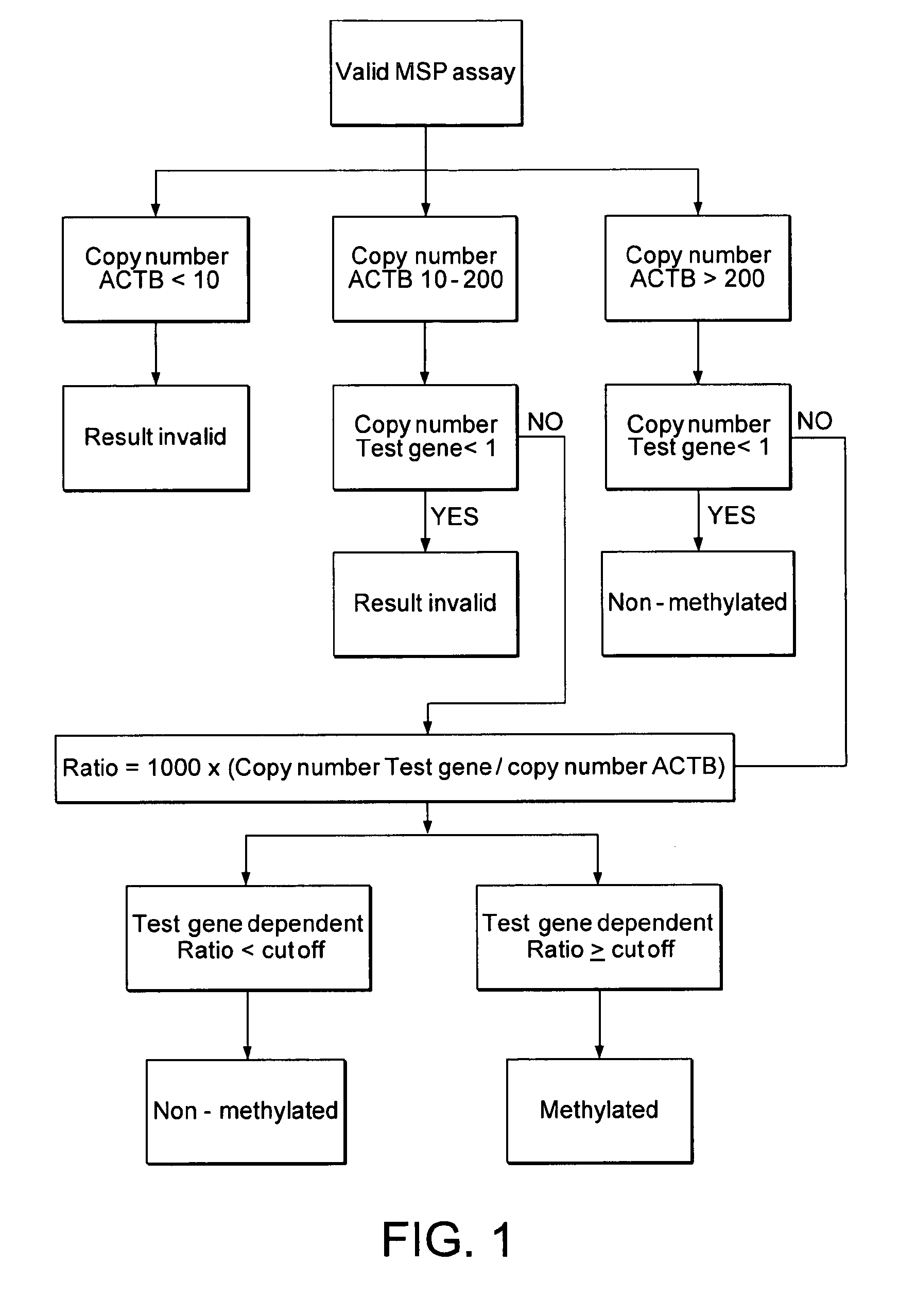Method for Determining the Methylation Status of the Promoter Region of the TWIST1 Gene in Genomic DNA from Bladder Cells
a technology of genomic dna and twist1 gene, which is applied in the direction of anti-antineoplastic agents, biochemistry apparatus and processes, drug compositions, etc., can solve the problems of high sensitive and specific production
- Summary
- Abstract
- Description
- Claims
- Application Information
AI Technical Summary
Benefits of technology
Problems solved by technology
Method used
Image
Examples
example 1
A Real-Time MSP Assay for Early Detection of Bladder Cancer—Urine Training Set 1
Materials and Methods
[0149]Marker identification: Candidate genes were identified using re-expression profiles of bladder cancer cell lines. Promoter sequences were linked with gene expression to identify valid epigenetically silenced genes. An established pharmacologic unmasking strategy (5-aza-2′-deoxycytidine [DAC] and trichostatin A [TSA]) for re-expression analysis of epigenetically targeted genes was combined with proprietary advanced bioinformatics tools to identify genes prone to promoter methylation.
Marker selection in bladder tissue: Marker candidates identified by re-expression were screened using 74 real-time methylation specific PCR (real-time MSP) assays. These assays were used to assess the methylation status of 59 gene promoters in formalin-fixed paraffin-embedded (FFPE) tissue samples collected from various urological clinics. Samples included 91 carcinomas of various stages and 39 sampl...
example 2
A Real-Time MSP Assay for Early Detection of Bladder Cancer—Urine Training Set 2
[0156]The 5-marker panel from Example 1 was further studied with an independent sample set, referred to as ‘urine training set 2’. Due to a reduction of the number of genes tested (5 instead of 11), a greater aliquot of sample was available for each assay tested, resulting in an adapted BT elution volume and a different decision tree (based on copies rather than ratios) for analyzing the results (FIG. 4).
Materials and Methods
[0157]Marker identification: Candidate genes were identified using re-expression profiles of bladder cancerous cell lines, as discussed in Example 1.
[0158]Marker selection: Differentially methylated genes were validated in tissue using real-time methylation specific PCR (real-time MSP). Best performing tissue markers were selected for testing DNA from urine samples, as discussed in Example 1.
[0159]Urine sample collection: Prospective, randomly collected urine samples from multiple ce...
example 3
Non-Invasive Combined Approach
[0180]To further enhance the sensitivity of the new urine-based DNA methylation assay, the inventors investigated the feasibility of combining their methylation test with established methods for the detection of early-stage bladder cancer in urine samples. Conventional urinary cytology (current standard-of-care procedure) and FGFR3 mutation analysis results (particularly useful for recurrence detection) were used to complement the methods of the invention.
Materials and Methods
[0181]Sample collection: samples from urine training set 1 and training set 2, as described in Examples 1 and 2, were used to demonstrate the utility of combining the methylation assay with cytology and / or FGFR3 mutation results.
Different Assays Tested:
[0182]OMS urine-based DNA methylation assay: Analyte (TWIST, RUNX3, NID2, and ACTB) quantifications were performed by real-time MSP assays as detailed above.
[0183]Urinary cytology: General procedure for cytology examination was appli...
PUM
 Login to View More
Login to View More Abstract
Description
Claims
Application Information
 Login to View More
Login to View More - R&D
- Intellectual Property
- Life Sciences
- Materials
- Tech Scout
- Unparalleled Data Quality
- Higher Quality Content
- 60% Fewer Hallucinations
Browse by: Latest US Patents, China's latest patents, Technical Efficacy Thesaurus, Application Domain, Technology Topic, Popular Technical Reports.
© 2025 PatSnap. All rights reserved.Legal|Privacy policy|Modern Slavery Act Transparency Statement|Sitemap|About US| Contact US: help@patsnap.com



